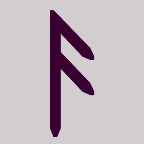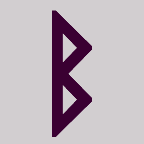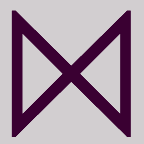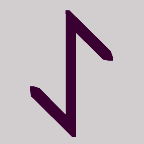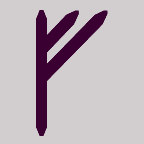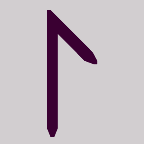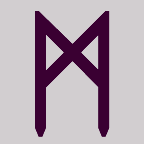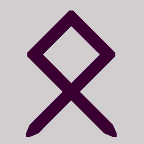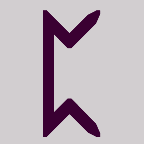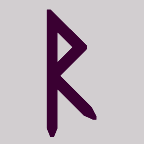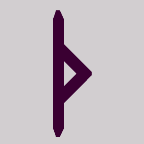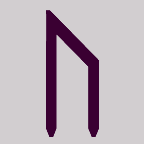About the Runes of the Elder Futhark!
 Rune Stones are an old and long recognized writing system, far more than most people believe. While most people think Viking or, thanks to Tolkein, Elf, or Hobbit when they hear the word “Rune,” the history is actually older and far more involved than that. Now lost to the pages of history, the origin of the rune is still unknown. Believed to have begun before the Christian era and having been a transmutation from the Iron Age pictographs to a phonetic representation. Those who follow the Viking Mythology believe that Odin was given the gift of the Runes after hanging suspended upside down from the World Tree Yggdrasil for a period of nine days. It was after receiving the Runes that he was finally able to come down from the tree.
Rune Stones are an old and long recognized writing system, far more than most people believe. While most people think Viking or, thanks to Tolkein, Elf, or Hobbit when they hear the word “Rune,” the history is actually older and far more involved than that. Now lost to the pages of history, the origin of the rune is still unknown. Believed to have begun before the Christian era and having been a transmutation from the Iron Age pictographs to a phonetic representation. Those who follow the Viking Mythology believe that Odin was given the gift of the Runes after hanging suspended upside down from the World Tree Yggdrasil for a period of nine days. It was after receiving the Runes that he was finally able to come down from the tree.
Yggdrasil for a period of nine days. It was after receiving the Runes that he was finally able to come down from the tree. In the 13th Century Saga of Eric The Red there is an indication of the status and value of the Rune casters held in the Teuton and Viking cultures.
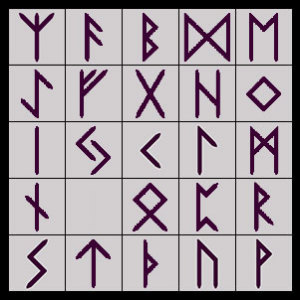 This relationship to the sacredness of earth energy is still seen in the modern use of Rune Stones as an oracle device. The Runes as an oracle goes back to
This relationship to the sacredness of earth energy is still seen in the modern use of Rune Stones as an oracle device. The Runes as an oracle goes back to
pre-historic times.
Runes were always carved into something that was “of the earth” such as stone, hardwood, leather, or metal. The runes were either carved or painted onto the items. Some runes have been colored with paint in which one of the components was human blood. These runes were considered to hold an even higher power and the words they represented were even more important because they were bound by blood to the stone. Called runemal, the Runemaster (or mistress) would shake their pouch and scatter the runes (made from whatever media, normally made by the Runemaster themselves to grant the personal power to the runes). Those which landed right side up were read as auguries of the future. In 98A.D, the Roman historian Tacitus gives us the best description of the prevalence of casting in Chapter X of his Germanica.
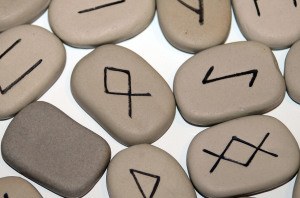 The Runes by this time were already developing a consistency on the European Continent. They were carried from place to place on the ancient trade routes, many warriors had them as part of their packs as they carried their weapons to the wars of the dark age. It is believed that by the time of Tacitus’ quote that the Runes were more than just squiggles on a stick. They were a recognized written language understood by those who had been educated in it.
The Runes by this time were already developing a consistency on the European Continent. They were carried from place to place on the ancient trade routes, many warriors had them as part of their packs as they carried their weapons to the wars of the dark age. It is believed that by the time of Tacitus’ quote that the Runes were more than just squiggles on a stick. They were a recognized written language understood by those who had been educated in it.
Through the centuries the Futhark (the name for the runic alphabet…this is based on the first six runes) has evolved. The Anglo-Saxon alphabets expanded on the Runes and had as many as 33 letters in Britain. However, it is the ancient Futhark, the elder stones, that are used for divinatory purposes. These were more common among the Germanic tribes. The twenty-four runes are broken down into three groups of eight and are named for gods from the Norse Pantheon. The first eight futhark are attributed to Freyr, the second eight to Hagal, and the third eight to Tyr.
Somewhere through the history of time, probably much later, the final Rune was added. This Rune is called the Blank Rune. Many represent this rune as being indicative of the emptiness or that the Runes are declining to answer. The Blank Rune is called “Odin’s Rune” and is emblematic of the endless possibilities of the Universe.
 As stated in our modality page on Runes, what are called “Rune Stones” today are actually a misnomer. Rune Stones truly do exist. There are standing stones which still contain their markings across the paths of the northern explorers. Rune stones were larger stones (some weighing multiple tons, some twenty pounds) which were inscribed with runes to mark boundaries, commemorate that “on this battlefield Sven of the long axe went berserk and killed twenty of the enemy – Hail Sven, sword arm of Lungar,” or to put the magic of the runes to work to bind a contract or treaty.
As stated in our modality page on Runes, what are called “Rune Stones” today are actually a misnomer. Rune Stones truly do exist. There are standing stones which still contain their markings across the paths of the northern explorers. Rune stones were larger stones (some weighing multiple tons, some twenty pounds) which were inscribed with runes to mark boundaries, commemorate that “on this battlefield Sven of the long axe went berserk and killed twenty of the enemy – Hail Sven, sword arm of Lungar,” or to put the magic of the runes to work to bind a contract or treaty.
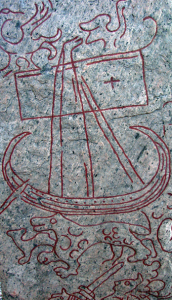 Today Runes are used by many for simple self-introspection, to look ahead, or just as a way to learn how to read an ancient language! Many of the sagas of the ancient tribes exist today, but only in their original languages. Many scholars and history buffs are learning to read the runes to enable them to peer into the depths of history. There are those, however, who take the time to truly go within and learn the information about themselves and the world around them, reconnect with the energies and can become true practitioners of runemal. Dr. Nikki is just such a person as she has been using the Runes for nearly twenty years.
Today Runes are used by many for simple self-introspection, to look ahead, or just as a way to learn how to read an ancient language! Many of the sagas of the ancient tribes exist today, but only in their original languages. Many scholars and history buffs are learning to read the runes to enable them to peer into the depths of history. There are those, however, who take the time to truly go within and learn the information about themselves and the world around them, reconnect with the energies and can become true practitioners of runemal. Dr. Nikki is just such a person as she has been using the Runes for nearly twenty years.
In this section we’ll break the Runes down for you, not only into their individual meanings, but also the representations included in being part of Freyr’s, Hagal’s, and Tyr’s Eight. Please click on the links to learn about the various Runes.



